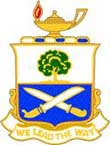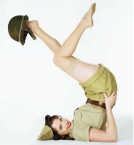Blackhorse
Posts: 1983
Joined: 8/20/2000
From: Eastern US
Status: offline

|
I was cleaning out my files, and stumbled upon these notes I prepared many months ago. They are by no means comprehensive - they don't discuss any of the Marine Corps design choices, fx, but on the off-chance anyone is interested. . .
US EARLY WAR LAND FORCES – DESIGNER NOTES
Harbor Defenses:
The permanent, fixed gun, coastal defense installations have been completely overhauled from stock. The suite of guns at each location are far more accurate, to include 8” and 14” railroad guns on Oahu and Los Angeles. “Harbor Defense” LCUs now upgrade during the war, shedding obsolete WWI 10” and 12” guns and mortars, and generally adding one or two “big guns” and some modern, smaller 90mm and 155mm CD guns.
Minefields:
IRL, the US had major mine fields only at San Francisco, Pearl Harbor, and the entrance to Manila Bay. There was a small minefield at Subic Bay (now part of the Clark Field hex). WitP-AE has a code that distributes minefields to all nationalities based on base/port size. For the US, all the historic minefields are included, and the code adds others to some of the larger West Coast cities.
US Army Organization:
The US Army was in the process of reorganizing from “square” four-regiment divisions to “triangular” three-regiment divisions when the war began. Most of regular army divisions had already converted. Most of the National Guard divisions were still square. However, every division converted to a three-regiment formation before it deployed. Some of the “surplus” fourth regiments became independent “Separate” Infantry Regiments. Other surplus regiments were combined to form new divisions, or to help turn one “square” division into two “triangular” ones.
For simplicity’s sake, regiments in AE start the game with their post-reorganization assignments. So the 132nd, 164th and 182nd regiments all belong to the Americal Division when they arrive in-game, even though they were actually part of the 33rd, 34th and 26th Divisions, respectively, when the war broke out.
Hawaii’s Missing 299th Infantry Regiment:
In October of 1941, the “square” Hawaiian Division was split in two to create the 24th and 25th “triangular” divisions. Each division received 2 regular army regiments. Their third regiments (299th to the 24th; 298th to the 25th) came from the Hawaiian National Guard. The 299th was detached from the 24th and sent to guard the outer islands. The National Guard regiments started the war understrength, and lost half their number when the Army discharged all soldiers of Japanese ancestry in early 1942. Reduced to skeletons, the two regiments were merged into one – the 298th – and made a separate regiment, guarding the positions held by the old 299th. By then, two other regiments that started the war in California (the 34th and 161st) were in Hawaii and they officially became the round-out regiments for the 24th and 25th divisions in July.
For simplicity’s sake, in AE, when the war begins the 24th and 25th Divisions each have two regiments on Oahu. The 298th and 299th have already been consolidated into the 298th Separate Infantry Regiment, defending the other islands. The 34th and 161st Regiments, arriving in San Francisco, start as part of the 24th and 25th Divisions in Hawaii.
No Regimental Combat Teams (RCTs)!
Unlike stock, In AE, there are no RCTs. Regimental Combat Teams were not official TO&E units in WWII. A typical RCT was an infantry regiment with attached battalions of artillery and anti-aircraft, an attached battalion or company of engineers, and occasionally some tanks. In AE, all of the artillery, AAA, engineers and tanks are in the game as separate units. So move a regiment of infantry to a base, reinforce it with other battalions as desired and, voila!, you have essentially created a RCT.
“Armored” Motorized Infantry and Mechanized Cavalry
The 7th Motorized Infantry Division, and 159th Motorized Infantry Regiment, as well as some West Coast Mechanized Cavalry units are classified as “Armored units.” This allows them to use the “armor” movement table, as they are fully motorized. They fight normally – the “Armor” designation only affects how they move.
The Motorized Division Experiment
Shortly after the war began, the US Army designated the 7th Infantry Division, defending the San Francisco area, to test the “Motorized Division” concept. A regular infantry division had enough trucks to carry 1/3rd of the division at a time; all the elements of a motorized division could move at once. During the test period, the 7th Motorized Division was not available to deploy overseas. By the end of 1942, the Army abandoned the motorized division concept, the 7th re-converted to regular infantry, and deployed to the Aleutians in April/May of 1943.
In AE, the 7th starts as a Motorized Infantry Division. It is the perfect unit to guard San Francisco, because it starts near there, is restricted to the West Coast and can not be shipped overseas. Since LCUs can not be “un-restricted” in the editor, in early 1943 the 7th Motorized Division withdraws, and is replaced by a ‘new’ 7th (unrestricted) Infantry Division, that can deploy to the Pacific.
Too Many Trucks!
Allied LCUs in AE have a lot more motorized support than they did in WitP. The Western Allies were far more dependent on trucks for movement and supply than the Japanese were. In AE, that is not a good thing for the Allied player. Motorized support takes up more shipping space than regular support, requires AKA and AK transports, and is devilishly hard to unload in small ports. Throughout the war, the US Army constantly struggled to reduce the number of trucks in each division, in order to alleviate the shipping shortage. When the infantry division TO&E upgrades in 42/7, motorized support drops from 266 to 184. Unlike the Army, Marine divisions were designed from the beginning with shipping economy in mind, and they require far less motorized support.
The Missing Cannon Companies
In 1942, TO&Es for Infantry Regiments were adjusted to add a “Cannon Company” of x6 75mm and x2 105mm self-propelled howitzers mounted on halftracks. However, only a few units ever adopted these changes, mostly in North Africa. In the Pacific, units generally added a battery of towed, short-barreled 105mm howitzers, instead. Unlike stock, the AE TO&E adds the towed weapons, not the “cannon companies.” I made a mistake that I need to patch eventually – I have several US reinforcements arriving in 1942 with the short-barreled 105s, but these guns were not actually available until 1943.
The Cheating AI Gets a Free Tahiti Vacation:
A battalion of the 102nd Separate Infantry Regiment, and a battalion of the 198th Coast Artillery Regiment (AA) arrive directly at Bora Bora in the South Pacific. Obviously, IRL, they were shipped over from the US, but in play tests the AI kept combining the sub-units of the two regiments en route, preventing the separate battalions from going to their assigned destinations. If we ever design a PBEM-only scenario, I’ll make these folks start back on the East Coast.
_____________________________
WitP-AE -- US LCU & AI Stuff
Oddball: Why don't you knock it off with them negative waves? Why don't you dig how beautiful it is out here? Why don't you say something righteous and hopeful for a change?
Moriarty: Crap!
|
 Printable Version
Printable Version














 New Messages
New Messages No New Messages
No New Messages Hot Topic w/ New Messages
Hot Topic w/ New Messages Hot Topic w/o New Messages
Hot Topic w/o New Messages Locked w/ New Messages
Locked w/ New Messages Locked w/o New Messages
Locked w/o New Messages Post New Thread
Post New Thread